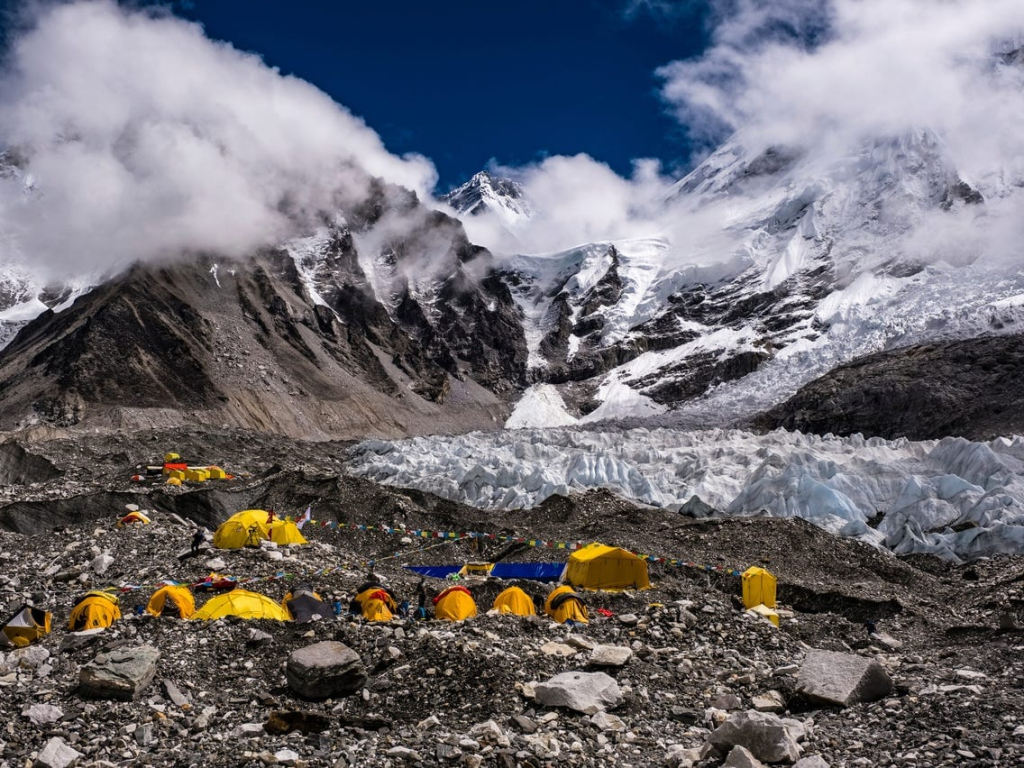The Everest Base Camp (EBC) trek journey is a dream for many adventurers and nature enthusiasts. It is at the base of the world’s highest peak, Mt. Everest. This surreal experience requires careful planning, especially when it comes to timing. The best time for the EBC trek can make a significant difference in the trekker’s overall experience. One has to consider from weather conditions to crowd levels. Here’s a detailed guide to help you choose the optimal time for your trek.
Peak Seasons for Everest Base Camp Trek: Spring and Autumn

The most popular times to trek to Everest Base Camp are during the pre-monsoon (spring) and post-monsoon (autumn) seasons. These periods offer the best weather conditions, with stable temperatures, clear skies, and breathtaking views.
1. Spring (March to May):
Spring is one of the most favored seasons for the EBC trek. During this time, the weather is relatively warm, and the trails are adorned with blooming rhododendrons and other vibrant flora. The temperatures during the day range from 10°C to 15°C (50°F to 59°F) in the lower altitudes, and it can get colder as you ascend. The nights can be chilly, especially at higher elevations, with temperatures dropping below freezing.
Advantages of Trekking in Spring:
- Pleasant daytime temperatures
- Lush and colorful landscapes
- Longer daylight hours for trekking
- Opportunity to witness climbers preparing for their Everest summit attempts
2. Autumn (September to November):
Autumn is another ideal season for trekking to Everest Base Camp. The monsoon rains subside, leaving behind clear skies and crisp mountain views. The temperatures are moderate, with daytime temperatures ranging from 12°C to 20°C (54°F to 68°F) in the lower altitudes and cooler temperatures at higher elevations. Nights can be cold, especially as you approach the base camp.
Advantages of Trekking in Autumn:
- Stable and dry weather conditions
- Crystal-clear mountain views
- Moderate temperatures for comfortable trekking
- Lesser chance of flight delays to and from Lukla due to clear weather
Off-Peak Seasons for Everest Base Camp Trek: Winter and Monsoon
While spring and autumn are the most popular trekking seasons, some adventurers prefer the solitude and unique experiences offered by the off-peak seasons. However, these times come with their own set of challenges and considerations.
1. Winter (December to February):
Trekking to Everest Base Camp in winter is for those who seek tranquility and are prepared for harsh weather conditions. The temperatures can drop significantly, especially at higher altitudes, with daytime temperatures ranging from -5°C to 5°C (23°F to 41°F) and much colder nights. The trails are less crowded, and the snow-covered landscapes offer a different kind of beauty.
Advantages of Trekking in Winter:
- Quieter trails with fewer trekkers
- Stunning snowy landscapes
- Clear skies with unobstructed mountain views
Challenges of Winter Trekking:
- Extremely cold temperatures, especially at night
- Higher risk of flight cancellations to and from Lukla due to weather conditions
- Limited teahouse availability as some may close for the season
2. Monsoon (June to August):
The monsoon season is the least popular time for the EBC trek due to heavy rainfall, muddy trails, and the risk of landslides. The temperatures are warmer, with daytime temperatures ranging from 15°C to 25°C (59°F to 77°F) in the lower altitudes, but the humidity can make trekking uncomfortable. However, the lush green landscapes and fewer crowds can appeal to some trekkers.
Advantages of Trekking in Monsoon:
- Lush, green scenery and blooming wildflowers
- Fewer trekkers on the trails
Challenges of Monsoon Trekking:
- Heavy rainfall leads to slippery and muddy trails
- Increased risk of landslides and trail obstructions
- Limited mountain views due to cloud cover
- Higher chances of flight delays and cancellations
Final Tips for Planning and Choosing the Best Time for Everest Base Camp Trek:
Research and Prepare: Regardless of the season, thorough preparation is key. Understand the weather conditions, pack appropriate gear, and train adequately for the trek.
Permits and Guides: Ensure you have the necessary permits and consider hiring a local guide or joining a trekking group for a safer and more enjoyable experience.
Health and Safety: Acclimatize properly to prevent altitude sickness, stay hydrated, and listen to your body.
Choosing the best time for the Everest Base Camp trek depends on your personal preferences, tolerance for different weather conditions, and desire for either a bustling or serene trekking experience. Whether you opt for the vibrant trails of spring, the clear vistas of autumn, the quiet of winter, or the lush greenery of monsoon, the journey to Everest Base Camp is bound to be an unforgettable adventure.
By understanding the advantages and challenges of each season, you can make an informed decision that aligns with your trekking goals and ensures a memorable experience on the trails of the Himalayas. But remember safety needs to be considered before anything else.
To book the trek now: Everest Base Camp Trek



